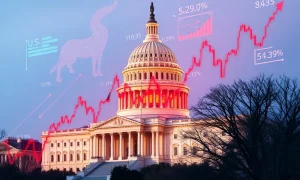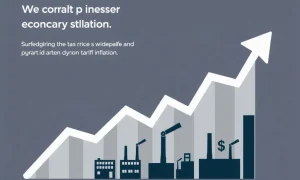Global financial markets experienced a sharp downturn this morning. This followed a dramatic escalation in the global trade war. President Donald Trump announced a new wave of tariffs on imports from 92 countries. Consequently, fears of a significant blow to international commerce and a renewed slowdown in global economic growth intensified.
The Immediate Impact of New Trump Tariffs
On Thursday night, President Trump’s administration revealed plans for a blanket 15 percent levy. This new tariff rate applies to imports from nearly half the world’s nations. This aggressive move immediately sent shockwaves through major bourses. Investors reacted with alarm to the prospect of disrupted supply chains and higher costs. Indeed, early trading saw substantial declines across Europe.
Specifically, Germany’s DAX index dropped by 1.1 percent. Furthermore, France’s CAC 40 fell by nearly 1 percent. Spain’s IBEX lost 0.6 percent. London’s FTSE 100 also saw a 0.5 percent decrease. This happened despite the UK and EU finalizing a trade deal with the US earlier this week. Clearly, the market’s apprehension superseded any recent positive trade news. These **Trump tariffs** signal a new phase of protectionism.
Economists Weigh In on Tariff Repercussions
Economists quickly warned that these sweeping **Trump tariffs** could severely damage business confidence. They also highlighted the potential for significant disruptions to global supply chains. This comes at a critical time. Global trade had just begun to stabilize following the widespread challenges of the post-pandemic era. Many businesses were just regaining their footing.
Atakan Bakiskan, a US economist at Berenberg Bank, expressed grave concerns. “This is a huge blow to global commerce,” he stated. “The tariffs distort competition between firms producing in the US and those based abroad.” Bakiskan emphasized how such measures create an uneven playing field. Companies operating outside the US face immediate cost disadvantages.
However, Bakiskan also offered a nuanced perspective. He noted that the blanket nature of the tariffs—a uniform 15 percent levy applied to all affected countries—might cushion the blow compared to a more targeted approach. “European, Japanese, and South Korean manufacturers tend to compete more with each other than directly with US producers,” he explained. “Since they’re all subject to the same tariff rate, the competitive distortion is less severe than if the US had singled out individual countries with varying tariffs.” Nevertheless, the overall sentiment among analysts remains cautious.
Broader Economic Fallout from Trump Tariffs
Financial markets are undeniably spooked. Analysts suggest that President Trump’s aggressive trade stance risks igniting retaliatory measures from affected nations. This could lead to a cascading effect of trade barriers worldwide. Such actions would further disrupt international supply chains. Ultimately, they would push up prices for consumers and businesses alike. Therefore, households could soon face higher costs for imported goods.
The announcement arrives during an already volatile period for the global economy. Inflationary pressures continue to linger in key markets. Central banks globally walk a tightrope, balancing potential interest rate cuts against persistent economic fragility. This new wave of **Trump tariffs** adds another layer of complexity to an already delicate situation. Policymakers now face increased pressure to respond effectively.
If sustained, these latest tariffs could also test the strength of recent transatlantic trade agreements. They might also challenge the willingness of major economies to maintain cooperation. This becomes particularly relevant in the face of mounting protectionist pressure. International relations could strain under the weight of these new economic policies. Nations might prioritize domestic interests over global trade harmony.
Historical Context of Trump’s Trade Policies
President Trump’s current actions echo his previous approach to international trade. During his first term, he famously imposed tariffs on steel and aluminum imports. He also initiated a significant trade war with China. These past measures aimed to protect domestic industries and reduce trade deficits. They often sparked intense debate among economists and trade partners. Many viewed them as disruptive to the established global trading system.
His previous trade policies, while controversial, did demonstrate a willingness to challenge long-standing agreements. They also highlighted a preference for bilateral negotiations over multilateral frameworks. This consistent approach indicates a strategic intent to reshape global commerce. However, critics often argued that these policies led to higher costs for American consumers and businesses. They also triggered retaliatory tariffs from other countries. These retaliatory measures often harmed US exporters, particularly in the agricultural sector. The current round of **Trump tariffs** follows a similar blueprint, signaling a continuation of this protectionist agenda.
Impact on Specific Sectors and Consumers
The blanket nature of these new **Trump tariffs** means a wide array of sectors will feel the pinch. Manufacturing industries, especially those reliant on imported components, face increased production costs. Automotive, electronics, and textile industries are particularly vulnerable. Companies must decide whether to absorb these higher costs, pass them on to consumers, or seek new, more expensive domestic suppliers.
Furthermore, consumers will likely bear the brunt of these tariffs. As import costs rise, so too do the prices of many everyday goods. This can lead to reduced purchasing power and a general decrease in consumer spending. In an economy already grappling with inflation, this additional price pressure is unwelcome. It could potentially dampen overall economic growth. Businesses might also face reduced profit margins, leading to less investment and potentially job losses. The ripple effect of these tariffs extends far beyond initial trade figures.
Navigating Supply Chain Disruptions and Strategic Shifts
Global supply chains have evolved over decades to optimize efficiency and cost. These new **Trump tariffs** directly threaten that delicate balance. Companies will need to reassess their sourcing strategies. Some might explore ‘reshoring’ production back to the US. Others could diversify their supply chains to countries not affected by the tariffs. Both options often involve significant investment and operational adjustments. These changes are not instantaneous. They can lead to delays and increased expenses in the short to medium term.
Large multinational corporations, with complex global networks, will face particularly arduous tasks. They must identify alternative suppliers, renegotiate contracts, and reconfigure logistics. Smaller businesses, with fewer resources, might struggle even more. They could find themselves squeezed between rising import costs and consumer resistance to higher prices. The long-term implications could see a fundamental shift in global manufacturing footprints. Companies may prioritize resilience and geographical diversification over pure cost efficiency. This strategic shift is a direct consequence of the escalating trade tensions.
Central Bank Dilemmas Amidst Economic Volatility
The current global economic landscape is already precarious. Central banks, including the US Federal Reserve and the European Central Bank, have been carefully managing inflation. They are also trying to support economic growth. The introduction of these new **Trump tariffs** complicates their efforts considerably. Tariffs are inherently inflationary. They increase the cost of imported goods, which can feed into broader price increases across the economy.
This inflationary pressure presents a dilemma for central bankers. If they cut interest rates to stimulate growth, they risk exacerbating inflation. If they maintain higher rates to combat inflation, they could stifle an economy already struggling with trade barriers. Therefore, the tariffs add a layer of uncertainty to monetary policy decisions. This uncertainty further contributes to market volatility. Investors watch closely for signals from central banks, hoping for clear guidance in these turbulent times. However, the path forward appears increasingly murky.
Investor Sentiment and the Road Ahead
Investor sentiment remains fragile. The uncertainty created by the **Trump tariffs** encourages a flight to safety. Investors often shift assets from riskier equities into more stable investments like government bonds. This movement can depress stock market valuations further. The unpredictable nature of trade policy under the current administration adds a significant risk premium to global assets. Businesses delay investment decisions. Consumers postpone large purchases. This wait-and-see approach can slow economic activity.
In the days ahead, investors will closely watch the response from affected nations. Will they retaliate with their own tariffs? Will they seek diplomatic solutions through international bodies like the World Trade Organization? The reaction of major economic blocs, such as the European Union and Asian powerhouses, will be crucial. These responses will dictate whether global markets can absorb yet another shock from the White House. The stability of international trade hangs in the balance, and the path forward remains uncertain.
Conclusion: A New Era of Trade Uncertainty
President Trump’s decision to unleash sweeping **Trump tariffs** on 92 countries marks a dramatic turning point in global economic relations. The immediate market reaction underscores the profound concerns within financial circles. Economists warn of damaged business confidence, disrupted supply chains, and increased inflationary pressures. While the blanket nature of the tariffs might mitigate some competitive distortions, the overall outlook remains grim.
This move intensifies an already volatile global economic climate. It challenges existing trade agreements and tests the resolve of international cooperation. The world now waits to see how affected nations will respond. Their actions will determine the ultimate trajectory of global commerce and economic growth. The coming weeks will be critical in shaping the future of international trade, demanding careful navigation from governments and businesses worldwide.
Frequently Asked Questions (FAQs) About Trump Tariffs
What are the new Trump tariffs?
President Donald Trump announced a new wave of tariffs, imposing a uniform 15 percent levy on imports from 92 countries. This sweeping measure aims to reshape global trade dynamics and protect domestic industries.
How do these Trump tariffs affect global markets?
These tariffs have caused global markets to slip sharply. Major indices in Europe and beyond have seen declines. Investors fear disruptions to international commerce, increased costs for businesses and consumers, and a renewed slowdown in global economic growth.
Which countries are most affected by these tariffs?
The tariffs apply to imports from 92 countries, making it a broad-based measure. While specific country impacts will vary, nations with significant export ties to the US across various sectors will feel the most immediate effects.
What is the economic rationale behind these Trump tariffs?
The stated rationale is often to protect domestic industries, encourage local production, and reduce trade deficits. Proponents argue that tariffs level the playing field for American companies against foreign competitors, although economists often point to negative consequences like higher consumer prices and retaliatory measures.
Will these tariffs lead to higher prices for consumers?
Yes, typically, tariffs lead to higher prices for consumers. Importers face increased costs, which they often pass on to retailers, and ultimately to the consumer. This can reduce purchasing power and contribute to inflation.
What could be the long-term consequences of these tariffs?
Long-term consequences could include significant shifts in global supply chains, potential retaliatory tariffs from affected nations, increased trade tensions, and a slowdown in global economic growth. They could also challenge the stability of existing international trade agreements.
























